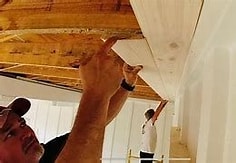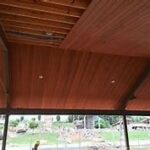Transforming a plain ceiling into a warm, inviting focal point often calls for the timeless appeal of tongue and groove paneling. This classic method not only enhances the visual charm of a space but also adds significant value to a home.
Though the task might seem daunting, especially for DIY enthusiasts, having the right tools can make the process both manageable and rewarding. Equipping yourself properly will ensure each panel fits seamlessly, creating a polished finish.
Embarking on this project requires careful planning and an understanding of the essential tools that help streamline the installation. In this post, we’ll explore the key tools that will guide you from layout to the final nail, ensuring a smooth and successful project.
Choosing the Right Tongue and Groove Ceiling Material
Selecting the right material for your tongue and groove ceiling is crucial to achieving both aesthetic appeal and lasting durability. Whether your style is rustic, modern, or somewhere in between, the material choice plays a vital role.
Wood is a popular choice, offering natural beauty and character. Options like pine and cedar are favored for their distinct grains and colors. However, wood requires maintenance to prevent warping and to keep its pristine look over time.
For those seeking minimal upkeep, engineered wood or PVC might be preferable. Engineered wood provides the warmth of true wood with added stability and resistance to moisture. PVC, on the other hand, is lightweight and good for areas prone to humidity, such as bathrooms.
Budget considerations also impact material choice. Natural wood can be more expensive, but the investment may be worth it for its timeless appeal. Alternatives like MDF provide a similar look at a lower cost, though they might lack wood’s durability.
Ultimately, the right material aligns with your design vision, maintenance commitment, and budget, setting the foundation for a successful ceiling installation.
Essential Tools for Tongue and Groove Ceiling Installation
Embarking on a tongue and groove ceiling installation requires a collection of essential tools to ensure a smooth and efficient process. Even with the right materials, without the proper tools, the project can become more challenging than necessary.
Measuring and Cutting Tools
Accuracy is key in any installation project. A measuring tape and T-square are fundamental for obtaining precise dimensions. These tools help create a seamless look by ensuring each piece fits perfectly into the next. For cutting, a saw suitable for the chosen material—whether a hand saw, jigsaw, or circular saw—is necessary to trim pieces to the right size.
Power tools can significantly speed up the installation. A power drill with a selection of drill bits is indispensable for pre-drilling holes. It makes the job of fastening the boards quick and straightforward. A nail gun is also highly recommended for securing the boards efficiently, leaving hands free for alignment.
Additional tools like a rubber mallet and pry bar help with minor adjustments, ensuring each piece is snugly fit without damaging the material. Safety glasses and gloves should be used throughout the process to protect the installer from any mishaps.
With these tools at hand, your tongue and groove ceiling installation can be smooth, successful, and satisfactory, resulting in a beautiful and lasting finish.
Preparing the Ceiling Surface for Installation
Before beginning the tongue and groove ceiling installation, it is crucial to prepare the surface adequately. Proper preparation helps ensure a smooth process and a high-quality finish.
Start by inspecting the ceiling for any signs of damage or irregularities. Look for uneven spots, moisture issues, or structural weaknesses that could affect the installation. Repairs should be completed before proceeding, as an even and stable surface is vital for successful installation.
Next, thoroughly clean the ceiling surface. Remove any dust, dirt, or grease that could interfere with the adhesion of the materials. A clean surface also helps in achieving a polished, professional look once the installation is complete.
Ensure the ceiling framework is sturdy and ready to support the weight of the new materials. Verifying the framework can prevent sagging or warping issues in the future. Take time to mark the locations of the ceiling joists, as these will guide the board placement, ensuring they are securely attached.
Once these preparatory steps are completed, the ceiling will be ready for the tongue and groove installation, setting the stage for a successful project.

Proper Techniques for Installing Tongue and Groove Ceiling Planks
Installing tongue and groove ceiling planks requires attention to detail and a few key techniques to ensure a professional finish. Begin by planning the layout of the planks. This step is essential to achieve a balanced and visually appealing ceiling, especially in rooms that are not perfectly square.
At the onset, measure the ceiling area accurately. Cut the planks to size, accounting for any irregularities in the room’s dimensions. An accurate cut is crucial to avoid gaps and ensure a snug fit between the boards.
Securing the First Plank
Start installation in one corner and work your way across the ceiling. Secure the first plank firmly using nails or screws, aligning it to the marked joists. It’s important to ensure the first board is straight, as it sets the foundation for the rest of the installation.
Continue by fitting the tongue of the next board into the groove of the previous one. Tap the planks gently with a rubber mallet to ensure they are tightly interlocked, creating a seamless appearance.
Working Across the Ceiling
As you progress, continue to check that the planks remain level and aligned. Adjust as necessary to maintain both aesthetic appeal and structural integrity. Trim the final plank of each row to fit tightly against the wall, maintaining the uniformity of the arrangement.
To complete the installation, secure each plank to the joists using a nail gun or hammer. This helps in sustaining the alignment and avoiding any shifting over time.
By following these techniques, you can achieve a stunning tongue and groove ceiling that enhances the room’s visual appeal.
Common Mistakes to Avoid During Tongue and Groove Ceiling Installation
When installing tongue and groove ceiling planks, certain mistakes can compromise the finish and longevity of your project. Awareness of these common pitfalls can save time and effort.
One major mistake is neglecting to acclimate the wood planks to the room’s environment before installation. Wood expands and contracts with changes in temperature and humidity, so it’s crucial to let the planks sit in the installation area for a few days before beginning.
Another frequent error is failing to adequately check and mark the ceiling joists. Without proper marking, you risk missing the joists when securing the planks, leading to weak support and a potentially uneven ceiling.
Improper alignment of the first plank can set off a chain reaction of misalignment throughout the installation. Always double-check the positioning and use a level to ensure the initial board is perfectly straight.
Finally, not using the right tools can hinder also progress. Invest in a quality nail gun and a rubber mallet to efficiently secure and adjust the planks without causing damage.
By avoiding these mistakes, your tongue and groove ceiling installation will not only look impressive but will stand the test of time.
Finishing Touches and Maintenance Tips
After laying the last plank, it’s time to add the final touches that will enhance your tongue and groove ceiling’s appearance and durability. A little attention to detail can make a significant difference.
Seal the surface with a clear finish or stain to protect the wood from moisture and stains. This not only safeguards the ceiling but also accentuates the natural grain, adding to the aesthetic appeal.
Regular Maintenance
Routine maintenance involves simple steps. Dust the ceiling regularly to prevent grime buildup. A microfiber cloth or a soft duster is effective for reaching those high spots.
In areas with fluctuating humidity, consider using a humidifier or dehumidifier to maintain consistent air moisture levels. This helps prevent wood from warping over time.
Annual inspections for signs of damage, such as cracks or gaps between the planks, are advisable. Promptly addressing these issues ensures your ceiling remains as beautiful as the day it was installed. Taking these measures will keep your ceiling looking pristine for years to come.
The Bottom Line: Achieving a Professional-looking Tongue and Groove Ceiling
In conclusion, creating a tongue and groove ceiling that captures a professional look is achievable with careful planning and attention to detail. While the task may seem daunting at first, breaking it down into manageable steps makes all the difference.
Start with a thorough preparation, ensuring you gather the right materials and tools. Taking the time to properly measure and cut the planks means fewer hurdles along the way. As you lay each plank, maintain a steady pace and check your progress frequently. This will help you catch any misalignments early, preventing future headaches.
What’s more, don’t underestimate the importance of those finishing touches. Sealing the wood not only preserves its natural beauty but also adds a coat of protection against any potential damage. Regular maintenance after installation is key to prolonging the life of your ceiling, keeping it as stunning as the day it was fitted.
Ultimately, a tongue and groove ceiling has the power to transform any space. With dedication and patience, you can achieve a result that not only meets but exceeds your expectations. This project allows for a personal touch, making every room feel unique and welcoming.
Remember, like any home improvement task, the journey to a professional-looking finish is as rewarding as the result itself. Enjoy the process, and the effort will undoubtedly speak for itself through your stunning ceiling.



